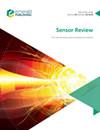用喷墨印刷技术制造柔性碳加热器和银交叉电极,用于电化学气体传感器
IF 1.4
4区 工程技术
Q3 INSTRUMENTS & INSTRUMENTATION
引用次数: 1
摘要
目的本文的目的是识别一种新的喷墨打印传感器制造技术,用于制造宏观和微观尺寸的柔性碳加热器、碳叉指(IDT)电极和银IDT电极。详细讨论了所提出的喷墨打印方法所涉及的技术以及用于自制纳米导电油墨(数字油墨)配方的材料。不同尺寸(宏观和微观)的喷墨打印柔性碳加热器以及碳IDT电极和柔性银IDT电极可以用作电化学气体传感器中的柔性传感层,用于敏感和选择性气体传感应用。讨论了在Kapton基片上喷墨打印碳加热器的特性及其结果。同样,本文首次报道了银纳米导电油墨的配方、银IDT电极在Kapton上的印刷及其表征结果。设计/方法/方法不同尺寸(宏观和微观)的柔性碳加热器,使用AutoCAD 2D开发了碳微IDT电极和银IDT电极图案,并在EpsonT60商用压电头的标准打印技术打印机的帮助下,使用自制的纳米导电油墨在Kapton(聚酰亚胺片)柔性基板上打印。发现所提出的新方法能够使用自制的碳和银纳米导电油墨,通过使用商业低成本打印机,在柔性基板上分别打印厚度约12µm和约1µm的加热器图案和IDT电极图案。自制的纳米导电油墨可重复使用,可多次印刷,保质期长达六个月。碳加热器的电阻在正常大气条件下测得为88Ω。对新型柔性碳加热器的功能进行了测试,结果令人满意。测得银IDT柔性电极的电阻为9.5O,比本文早期的工作要好。研究局限性/含义主要挑战与现有商业打印机中打印喷墨系统的清洁有关。在不久的将来对现有打印机进行定制可以最大限度地减少打印挑战。实际意义本文提出的新型喷墨打印技术具有成本效益,能够实现柔性传感器元件的批量生产,并且消耗最少的器件制造时间和较高的材料成品率。印刷可以用带有定制的纳米导电油墨的基于压电头的商用喷墨打印机来完成。这篇论文有巨大的市场潜力。独创性/价值首次使用商用打印机将碳加热器和银IDT电极打印在Kapton柔性基板上。该论文有望在大规模生产的柔性低成本传感器制造方面取得革命性进展,是薄膜和厚传感器制造方法的替代品。传感器制造技术的未来将是喷墨打印方法。本文报道了柔性碳加热器和柔性银IDT电极的研究进展。对碳加热器和银IDT电极进行了表征,并证实了该结果有利于气体传感器的应用。本文章由计算机程序翻译,如有差异,请以英文原文为准。
Fabrication of flexible carbon heaters and silver interdigitated electrodes using ink-jet printing technology for electro-chemical gas sensor applications
Purpose
The purpose of this paper is to deal with an identification of a novel ink-jet printing sensor fabrication technology for fabricating flexible carbon heaters of macro and micro sizes, carbon interdigitated (IDT) electrodes and silver IDT electrodes. The technology involved in the proposed ink-jet printing method and materials used for the formulation of homemade nano-conductive inks (digital inks) are discussed in detail. The ink-jet printed flexible carbon heaters of different sizes (macro and micro) and carbon IDT electrodes and flexible silver IDT electrodes can be used as the flexible sensing layers in electrochemical gas sensors for sensitive and selective gas sensing applications. The characterization of ink-jet printed carbon heaters on Kapton substrate and its results are discussed. Similarly, the results of formulation of silver nano-conductive ink and printing of silver IDT electrodes on Kapton and its characterization are reported here for the first time.
Design/methodology/approach
Flexible carbon heaters of different sizes (macro and micro), carbon micro-IDT electrodes and silver IDT electrodes patterns were developed using AutoCAD 2D and printed on the Kapton (polyimide sheet) flexible substrate using the home-made nano-conductive inks with the help of EpsonT60 commercial piezo-head-based drop-on demand technology printer with standard printing options.
Findings
The proposed novel method is able to print heater patterns and IDT electrode patterns of approximately 12 µm and approximately 1 µm thickness, respectively, on flexible substrate using the home-made nano-conductive inks of carbon and silver by using a commercial low-cost printer. The home-made nano-conductive inks can be re-used for multiple prints up to six months shelf life. The resistance of the carbon heater was measured as 88 O under normal atmospheric condition. The novel flexible carbon heater was tested for its functionality and found to be satisfactory. The resistance of the silver IDT flexible electrodes was measured as 9.5 O which is better than the earlier works carried out in this paper.
Research limitations/implications
The main challenge is associated with cleaning of printing ink ejection system in the existing commercial printers. The customization of the existing printer in the near future can minimize the printing challenges.
Practical implications
The novel ink-jet printing technology proposed in this work is cost-effective, capable of achieving bulk production of flexible sensor elements, and consumes the least device fabrication time and high material yielding. The printing can be done with commercial piezo-head-based ink-jet printers with custom-prepared nano-conductive inks. There is a huge market potential for this paper.
Originality/value
Both the carbon heaters and silver IDT electrodes were printed on Kapton flexible substrate by using the commercial printer for the first time. The paper is promising the revolution in flexible low-cost sensor fabrication for mass production, and it is an alternate for thin film and thick sensor fabrication methods. The future of sensor fabrication technology will be the ink-jet printing method. In this paper, the research developments of flexible carbon heaters and flexible silver IDT electrodes for the time are reported. The characterization of carbon heaters and silver IDT electrodes were carried out and confirmed that the results are favourable for gas sensor applications.
求助全文
通过发布文献求助,成功后即可免费获取论文全文。
去求助
来源期刊

Sensor Review
工程技术-仪器仪表
CiteScore
3.40
自引率
6.20%
发文量
50
审稿时长
3.7 months
期刊介绍:
Sensor Review publishes peer reviewed state-of-the-art articles and specially commissioned technology reviews. Each issue of this multidisciplinary journal includes high quality original content covering all aspects of sensors and their applications, and reflecting the most interesting and strategically important research and development activities from around the world. Because of this, readers can stay at the very forefront of high technology sensor developments.
Emphasis is placed on detailed independent regular and review articles identifying the full range of sensors currently available for specific applications, as well as highlighting those areas of technology showing great potential for the future. The journal encourages authors to consider the practical and social implications of their articles.
All articles undergo a rigorous double-blind peer review process which involves an initial assessment of suitability of an article for the journal followed by sending it to, at least two reviewers in the field if deemed suitable.
Sensor Review’s coverage includes, but is not restricted to:
Mechanical sensors – position, displacement, proximity, velocity, acceleration, vibration, force, torque, pressure, and flow sensors
Electric and magnetic sensors – resistance, inductive, capacitive, piezoelectric, eddy-current, electromagnetic, photoelectric, and thermoelectric sensors
Temperature sensors, infrared sensors, humidity sensors
Optical, electro-optical and fibre-optic sensors and systems, photonic sensors
Biosensors, wearable and implantable sensors and systems, immunosensors
Gas and chemical sensors and systems, polymer sensors
Acoustic and ultrasonic sensors
Haptic sensors and devices
Smart and intelligent sensors and systems
Nanosensors, NEMS, MEMS, and BioMEMS
Quantum sensors
Sensor systems: sensor data fusion, signals, processing and interfacing, signal conditioning.
 求助内容:
求助内容: 应助结果提醒方式:
应助结果提醒方式:


